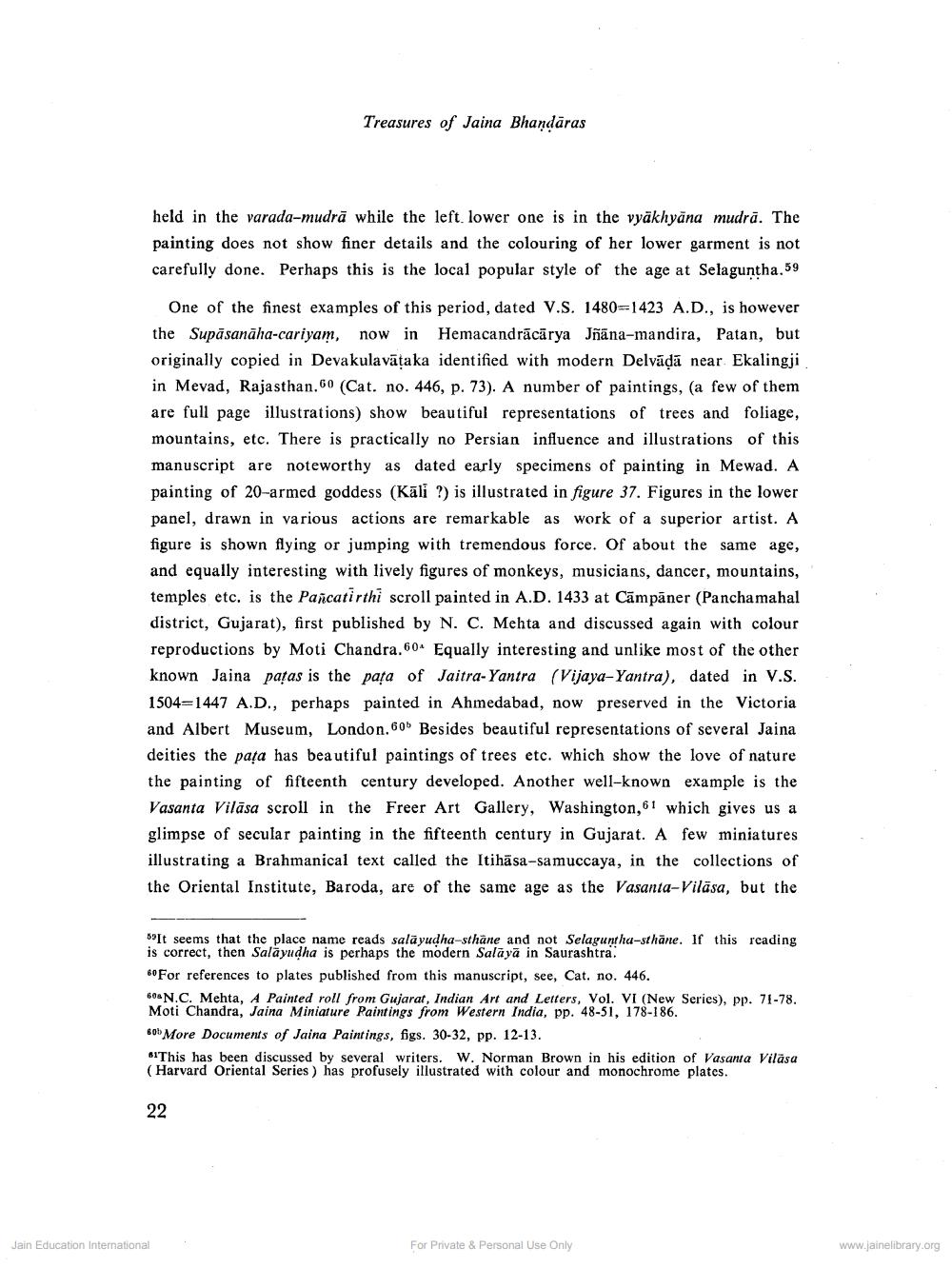________________
Treasures of Jaina Bhandaras
held in the varada-mudrā while the left. lower one is in the vyākhyāna mudra. The painting does not show finer details and the colouring of her lower garment is not carefully done. Perhaps this is the local popular style of the age at Selaguntha.59
One of the finest examples of this period, dated V.S. 1480=1423 A.D., is however the Supā sanāha-cariyam, now in Hemacandrācārya Jñāna-mandira, Patan, but originally copied in Devakulavātaka identified with modern Delvādā near Ekalingji in Mevad, Rajasthan.Go (Cat. no. 446, p. 73). A number of paintings, (a few of them are full page illustrations) show beautiful representations of trees and foliage, mountains, etc. There is practically no Persian influence and illustrations of this manuscript are noteworthy as dated early specimens of painting in Mewad. A painting of 20-armed goddess (Kāli ?) is illustrated in figure 37. Figures in the lower panel, drawn in various actions are remarkable as work of a superior artist. A figure is shown flying or jumping with tremendous force. Of about the same age, and equally interesting with lively figures of monkeys, musicians, dancer, mountains, temples etc. is the Pañcatirthi scroll painted in A.D. 1433 at Cāmpāner (Panchamahal district, Gujarat), first published by N. C. Mehta and discussed again with colour reproductions by Moti Chandra.60Equally interesting and unlike most of the other known Jaina pațas is the pata of Jaitra-Yantra (Vijaya-Yantra), dated in V.S. 1504=1447 A.D., perhaps painted in Ahmedabad, now preserved in the Victoria and Albert Museum, London.606 Besides beautiful representations of several Jaina deities the pața has beautiful paintings of trees etc. which show the love of nature the painting of fifteenth century developed. Another well-known example is the Vasanta Vilāsa scroll in the Freer Art Gallery, Washington, 61 which gives us a glimpse of secular painting in the fifteenth century in Gujarat. A few miniatures illustrating a Brahmanical text called the Itihāsa-samuccaya, in the collections of the Oriental Institute, Baroda, are of the same age as the Vasanta-Vilāsa, but the
$It seems that the place name reads salāyudha-sthane and not Selaguntha-sthäne. If this reading is correct, then Salāyudha is perhaps the modern Salāyā in Saurashtra. coFor references to plates published from this manuscript, see, Cat. no. 446. 608N.C. Mehta, A Painted roll from Gujarat, Indian Art and Letters, Vol. VI (New Series), pp. 71-78. Moti Chandra, Jaina Miniature Paintings from Western India, pp. 48-51, 178-186. &ob More Documents of Jaina Paintings, figs. 30-32, pp. 12-13. 61This has been discussed by several writers. W. Norman Brown in his edition of Vasanta Vilāsa (Harvard Oriental Series ) has profusely illustrated with colour and monochrome plates.
22
Jain Education International
For Private & Personal Use Only
www.jainelibrary.org




